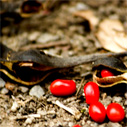My plan on returning home was always to pass right through and into something new. Not to turn my back on the people I know and the work I do in that place they call the Real World, but to augment it. To do more. More of the things that excite me. More of the things that fill not just a day, but a life with purpose. It’s that plan that has drawn me to the beautiful but oh-so-tiny town of Grahamstown in the Eastern Cape of South Africa for the remainder of this year. To study photojournalism.
It’s been an adjustment – barely five days’ space between arriving back from Cairo to carrying a car’s worth of life into my little cottage. While the swiftly changing scenery – and life – has meant that I have thus far successfully avoided post-adventure depression, my new life and environment at Rhodes University is quite different from anything I left in November last year.
In a way, moving here and enrolling was the simplest thing in the world. Just a car trip, some paperwork and a bit of organising away from the space I occupied before. In other respects, it’s one of the scariest things I’ve ever done.
I am sure that I will stop doing it in time, but it is hard not to articulate the inevitable comparisons between Rhodes and my previous experiences of undergrad at the University of the Witwatersrand. Where Wits was a disorganised behemoth, Rhodes is a nimble rogue. Where Wits sprawled with its tens of thousands of students across four or five campuses, Rhodes has but one, sprinkled liberally (pun intended) with Arts majors and a few Science, Journ. and Law folk thrown in for seasoning. Most striking, however, is that where Wits is forever associated in my head with the purple flowers of the Jacaranda tree, Rhodes appears to have not a one. In their place, mixed in with the gravel of pavements, the grass of sidewalks and so many local gardens are tiny little red seeds.
Growing up, I was taught that they were called ‘lucky beans’. It was never clear why they were lucky, except that it was definitely not if you ate them. Oh the useful things I learned as a child. It is only many years and an Internet later that I have learned that they come from the Coral Tree, were used as lucky charms in the past and are sometimes planted on the graves of chiefs.
It’s funny how, of all the things to fixate on and associate this place with, it is the lucky bean that has become stuck in my mind. Not the occasional donkeys in the street. Not the people swearing in Afrikaans the way it was meant to be sworn in. Not even the skies of the Eastern Cape that seem somehow to stretch further, to cover more than their brethren elsewhere. All of these things are here, making life outside the front door as entertaining as it will be educational (from tomorrow, when lectures start). It is the tiny little lucky bean, though, that is this place for me.
In a way, moving here and enrolling was the simplest thing in the world. Just a car trip, some paperwork and a bit of organising away from the space I occupied before. In other respects, it’s one of the scariest things I’ve ever done. People are not supposed to pursue seriously divergent ways of thinking and being. We create our own pressures to be armies of specialists, not adventurous generalists. So I worried. Worried whether the people from my life in Johannesburg would understand and stay close, or chalk me up as a reckless dreamer and drift.
With every day that passes, I see more beans. And I realise that people, deep down, feel similar pulls in their own lives. Wanting to do the things that matter to them the most, I am realising that I shouldn’t be surprised that people understand. Everyone is, after all, looking for their own lucky beans – that chance to squeeze fate until it yields. I am thankful that this place has buried me in them.


